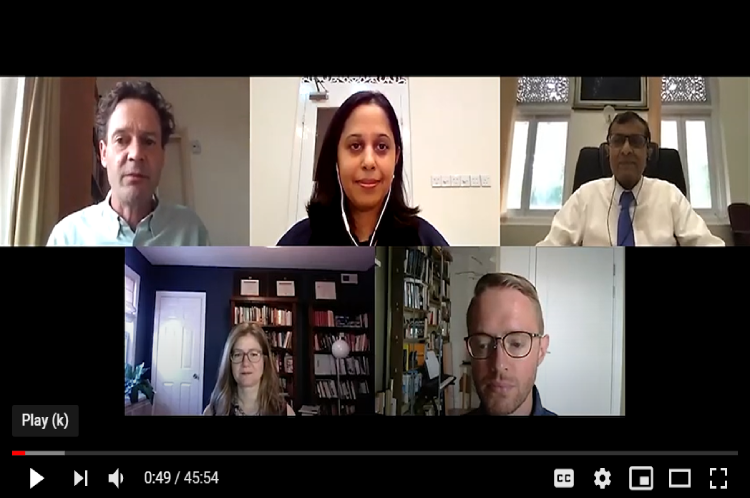Takeaways – The Impact of China’s Belt and Road Initiative: Lessons from Sri Lanka, Webinar hosted by Chatham House
August 25, 2020 Reading Time: 3 minutes

Reading Time: 3 min read
Three key takeaways from the webinar ‘The Impact of China’s Belt and Road Initiative – Lessons from Sri Lanka’:
- The data on debt dynamics does not suggest China has engulfed Sri Lanka in a debt trap.
- The ‘debt trap’ narrative obscures details of the local impact of Chinese investment and limits discussion on how best to benefit from Chinese investment at a local level.
- Guardrails in the form of economic, environmental, and social feasibility studies are vital for Chinese infrastructure projects in Sri Lanka as they reduce the risk of loaning for political reasons.
Introduction
- Dr. Ganeshan Wignaraja, Executive Director, Lakshman Kadirgamar Institute of International Relations and Strategic Studies (LKI); and Nonresident Fellow and former Executive Director of LKI, Dr. Dinusha Panditaratne, spoke at a webinar on ‘The Impact of China’s Belt and Road Initiative: Lessons from Sri Lanka’, which was hosted on 29 June 2020 by Chatham House, an independent think tank in the UK.
- Dr. Alyssa Ayres, Senior Fellow of the Council on Foreign Relations and Dr. Lee Jones, Reader in International Politics at the Queen Mary University of London, provided reflections and comments.
- The discussion was moderated by Mr. Gareth Price, Senior Research Fellow of the Asia-Pacific Programme at Chatham House.
Takeaways from Dr. Ganeshan Wignaraja:
- Dr. Ganeshan Wignaraja noted that Sri Lanka is a medium-level recipient of Chinese infrastructure investment and has benefited economically from Chinese infrastructure investment, especially in terms of expressways, ports, and energy plants.
- The data on debt dynamics does not suggest China has engulfed Sri Lanka in a debt trap; although to avoid a debt trap in the future, Sri Lanka must improve its debt management system, reduce its debt vulnerabilities, and increase transparency. Sri Lanka should also request a moratorium on interest payments of Chinese debt for 3 years to facilitate debt sustainability.
- Chinese infrastructure investment projects also result in other macroeconomic challenges such as trade deficits and a lack of spillovers. Sri Lanka should strive for a major export push to get Sri Lankan exports into Chinese markets, which will require cutting red tape and other regulatory reforms.
- He concluded his remarks by observing that Chinese investments entail costs and benefits at both the project level and the macroeconomic level. Sri Lanka must explore ways to maximise the potential benefits while mitigating the costs
Takeaways from Dr. Dinusha Panditaratne:
- Speaking on implications for institutions and governance, Dr. Panditaratne explained that while in principle Sri Lanka follows a non-aligned foreign policy, in practice it has swung between Western and non-Western partners depending on the political party in power. Chinese investment has defied this traditional swing and now become a constant element of Sri Lanka’s foreign policy and economic development.
- Dr. Panditaratne observed that the ‘debt trap’ narrative has been unhelpful in that it obscures details of the local impact of Chinese investment and limits the discourse on how best to benefit from Chinese investment. For example, Sri Lanka can develop a long-term (minimum 20 years) evidence-based infrastructure development plan, which reflects trends in demography, climate change, technology, and similar aspects. Such planning would minimise the risks associated with ad-hoc infrastructure projects.
- Commenting on the nexus between Chinese investment and democratic institutions, she noted the report’s recommendation to prohibit foreign political donations. Sri Lanka is rare in permitting such donations, which in turn decreases public trust in foreign investment projects.
Takeaways from Dr. Alyssa Ayres:
- Chinese debt does not dominate Sri Lankan debt. However, when lending from multilateral development banks, elements such as the lack of conditionality and an eventual 99-year lease of the receiving country’s property would not happen in a multilateral bank loan.
- When looking at the process of multilateral bank financing, there are clear guardrails in the form of economic, environmental, and social feasibility studies which take place prior to project approval. She suggests this approach is vital for Chinese infrastructure projects in Sri Lanka going forward as it eliminates the risk of loans for political reasons.
- Dr. Ayres also reiterated the need for skill transfers and knowledge sharing among Chinese and Sri Lankan workers.
Takeaways from Dr. Lee Jones:
- Commenting on the report, “Chinese Investment and the BRI in Sri Lanka”, Dr. Jones underscored the fact that there is a real infrastructure need in Sri Lanka and in many parts of the developing world.
- He traced criticism of Chinese development finance to weak regulations on the part of China, and the outsourcing of development planning by developing states.
- Dr. Jones stated that the Chatham House report has addressed misconceptions surrounding the Hambantota port, especially the fact that the port had not been transferred to China and that there has been no equity swap. He pointed out that the loans obtained to build the Hambantota port are still owed and the investments that came in was used to stabilize Sri Lanka’s balance of payments and pay off expensive and mostly Western creditors; the real debt trap that Sri Lanka got itself into.
